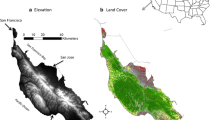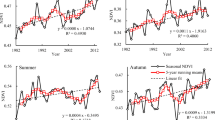Abstract
Long-term trends in vegetation phenology indicate ecosystem change due to the combined impacts of human activities and climate. In this study we used 1982 to 2006 Advanced Very High Resolution Radiometer Normalized Difference Vegetation Index (AVHRR NDVI) imagery across China and the TIMESAT program to quantify annual vegetation production and its changing trend. Results showed great spatial variability in vegetation growth and its temporal trend across the country during the 25-year study period. Significant decreases in vegetation production were detected in the grasslands of Inner Mongolia, and in industrializing regions in southern China, including the Pearl River Delta, the Yangtze River Delta, and areas along the Yangtze River. Significant increases in vegetation production were found in Xinjiang, Central China, and North-east China. Validation of the NDVI trends and vegetated area changes were conducted using Landsat imagery and the results were consistent with the analysis from AVHRR data. We also found that although the causes of the vegetation change vary locally, the spatial pattern of the vegetation change and the areas of greatest impact from national policies launched in the 1970s, such as the opening of economic zones and the ‘Three-North Shelter Forest Programme’, are similar, which indicates an impact of national policies on ecosystem change and that such impacts can be detected using the method described in this paper.
Similar content being viewed by others
References
Chen J, Jönsson P, Tamura M, Gu Z, Matsushita B, Eklundh L (2004). A simple method for reconstructing a high-quality NDVI time-series data set based on the Savitzky-Golay filter. Remote Sens Environ, 91 (3–4): 332–344
Eklundh L, Jönsson P (2003). Extracting information about vegetation seasons in Africa from Pathfinder AVHRR NDVI imagery using temporal filtering and least-squares fits to asymmetric Gaussian functions. In: Sebastiano B. Serpico, ed. Image and Signal Processing for Remote Sensing VIII. Proceedings of the SPIE (4885): 215–225
Eklundh L, Olsson L (2003). Vegetation index trends for the African Sahel 1982–1999. Geophys Res Lett, 30(8): 1430
European Commission (2003). Global Land Cover 2000 Database. Joint Research Centre
European Space Agency (2004–2006). GlobCover (version 2): Global Land Cover from MERIS
Hansen M, DeFries R, Townshend J, Sohlberg R (1998). UMD Global Land Cover Classification, 1 Kilometer, 1.0, Department of Geography, University of Maryland, College Park, Maryland, 1981–1994
Heilig G K (1997). Anthropogenic factors in land-use change in China. Popul Dev Rev, 23(1): 139–168
Heumann B W, Seaquist J W, Eklundh L, Jönsson P (2007). AVHRR derived phenological change in the Sahel and Soudan, Africa, 1982–2005. Remote Sens Environ, 108(4): 385–392
Jönsson P, Eklundh L (2002). Seasonality extraction by function fitting to time-series of satellite sensor data. IEEE Trans Geosci Rem Sens, 40(8): 1824–1832
Jönsson P, Eklundh L (2003). Seasonality extraction from satellite sensor data. In: Chen C H, ed. Frontiers of Remote Sensing Information Processing. Singapore: World Scientific Publishing. 487–500
Jönsson P, Eklundh L (2004). TIMESAT—a program for analyzing time-series of satellite sensor data. Comput Geosci, 30(8): 833–845
Lee R, Yu F, Price K P, Ellis J, Shi P (2002). Evaluating vegetation phenological patterns in Inner Mongolia using NDVI time-series analysis. Int J Remote Sens, 23(12): 2505–2512
Li H, Wang X, Chen S, Hou P (2005). Dynamic analysis and evaluation of Xinjiang forest resources: based on RS and GIS. J Geogr Sci, 15(3): 346–352
Liu J, Liu M, Tian H, Zhuang D, Zhang Z, Zhang W, Tang X, Deng X (2005). Spatial and temporal patterns of China’s cropland during 1990–2000: an analysis based on Landsat TM data. Remote Sens Environ, 98(4): 442–456
Lloyd D (1990). A phenological classification of terrestrial vegetation cover using shortwave vegetation index imagery. Int J Remote Sens, 11(12): 2269–2279
Lucht W, Prentice I C, Myneni R B, Sitch S, Friedlingstein P, Cramer W, Bousquet P, Buermann W, Smith B (2002). Climatic control of the high-latitude vegetation greening trend and Pinatubo effect. Science, 296(5573): 1687–1689
Markon C J, Fleming M D, Binnian E F (1995). Characteristics of vegetation phenology over the Alaskan landscape using AVHRR time-series data. Polar Rec (Gr Brit), 31(177): 179–190
Mather P M (2004). Computer Processing of Remotely Sensed Images: an Introduction. Chichester: John Wiley & Sons
Moulin S, Kergoat L, Viovy N, Dedieu G (1997). Global-scale assessment of vegetation phenology using NOAA/AVHRR satellite measurements. J Clim, 10(6): 1154–1170
Myneni R B, Keeling C D, Tucker C J, Asrar G, Nemani R R (1997). Increased plant growth in the northern high latitudes from 1981–1991. Nature, 386(6626): 698–702
Piao S, Fang J, Ji W, Guo Q, Ke J, Tao S (2004). Variations in a satellite-based vegetation index in relation to climate in China. J Veg Sci, 15(2): 219–226
Piao S, Fang J, Zhou L, Ciais P. Zhu B (2006). Variations in satellite-derived phenology in China’s temperate vegetation. Global Change Biology, D12103(12): 14
Raynolds M K, Walker D A, Maier H A (2006). NDVI patterns and phytomass distribution in the circumpolar Arctic. Remote Sens Environ, 102(3–4): 271–281
Slayback D A, Pinzon J E, Los S O, Tucker C J (2003). Northern hemisphere photosynthetic trends 1982–99. Glob Change Biol, 9(1): 1–15
Tucker C J, Pinzon J E, Brown M E, Salyback D A, Pak E W, Mahoney R, Vermote E F, Saleous E N (2005). An extended AVHRR 8-km NDVI data set compatible with MODIS and SPOT vegetation NDVI data. Int J Remote Sens, 26(20): 4485–4498
Tucker C J, Slayback D A, Pinzon J E, Los S O, Myneni R B, Taylor M G (2001). Higher northern latitude NDVI and growing season trends from 1982 to 1999. Int J Biometeorol, 45: 184–190
White M A, Hoffman F, Hargrove W W, Nemani R R (2005). A global framework for monitoring phenological responses to climate change. Geophys Res Lett, 32(4): L04705
White M A, Thornton P E, Running S (1997). A continental phenology model for monitoring vegetation responses to interannual climatic variability. Global Biogeochem Cycles, 11(2): 217–234
Xu W, Wu B, Yan C (2004). Detecting vegetation change during the period 1998–2002 in NW China using SPOT-VGT NDVI time-teries data. IEEE International Geoscience and Remote Sensing Symposium, 3417–3419
Yabuki S (1995). China’s New Political Economy: the Giant Awakes. Boulder: Westview Press
Yang S, Shi Z, Zhao H, Li P, Dai S, Gao A (2004). Effects of human activities on the Yangtze River suspended sediment flux into the estuary in the last century. Hydrol Earth Syst Sci, 8(6): 1210–1216
Zhang X, Friedl M A, Schaaf C B (2006). Global vegetation phenology from moderate resolution imaging spectroradiometer (MODIS): evaluation of global patterns and comparison with in situ measurements. Journal of Geophysical Research, G04017(111): 14
Zhang X, Friedl M A, Schaaf C B, Strahler A H, Hodges J C, Gao F, Reed B, Huete A (2003). Monitoring vegetation phenology using MODIS. Remote Sens Environ, 84(3): 471–475
Zhou L M, Tucker C J, Kaufmann R K, Slayback D, Shabanov N V, Myneni R B (2001). Variations in northern vegetation activity inferred from satellite data of vegetation index during 1981 to 1999. J Geophys Res Atmos, 106(D17): 20069–20083
Author information
Authors and Affiliations
Corresponding author
Additional information
Haiyan Wei is an assistant research scientist at the University of Arizona. She earned her Ph.D. in Watershed Management, with a minor in Remote Sensing. Her area of interest includes hydrology and erosion modeling, remote sensing application, and rangeland drought management.
Philip Heilman is the Research Leader at the Southwest Watershed Research Center. He has an undergraduate degree in Economics and Ph.D. in Watershed Management, with minors in Agricultural Economics and Management Information Systems. His research interests include decision support systems, water quality, rangeland management, and natural resource economics.
Mark A. Nearing is a research scientist at the Southwest Watershed Research Center in Tucson, Arizona. His area of research includes 1) determining sustainable land use and management practices with regard to soil, water, plant, and other watershed resources, 2) developing suitable computer simulation models to assess soil sustainability, 3) incorporating new technologies into the models and new measurement technologies into field experiments, and 4) developing technology transfer to disseminate research findings and results to land managers and decision makers. Dr. Nearing has authored more than 300 scientific papers, including more than 120 refereed scientific journal articles. Most of his research has been in the area of soil erosion research, including understanding basic erosion processes, field measurement techniques, computer simulation modeling, and understand global change impacts on erosion and conservation. He is past President and serves on the Board of Directors of the International Soil Conservation Organization, was a contributing author to Working Group II, Ch. 3, regarding the impacts of climate change on soil erosion to the 4th IPPC (Intergovernmental Panel on Climate Change) Assessment report, 2007, and is a Fellow of the Soil Science Society of America.
Zhihui Gu obtained her Ph. D. in Environmental Change and Regional Planning from Beijing Normal University, China. She is currently an assistant research professor at the college of Architecture and Urban Planning, Shenzhen University, China. Her area of expertise includes biological applications of remote sensing and urban disaster risk assessment.
Yongguang Zhang obtained his Ph.D. degree of physical geography from Beijing Normal University, China. He is currently an assistant research scientist at USDAARS Southwest Watershed Research Center and the University of Arizona. His area of research includes soil erosion, the impacts of climate change on soil and water conservation, and the climate extremes effects on terrestrial ecosystem productivity.
Rights and permissions
About this article
Cite this article
Wei, H., Heilman, P., Qi, J. et al. Assessing phenological change in China from 1982 to 2006 using AVHRR imagery. Front. Earth Sci. 6, 227–236 (2012). https://doi.org/10.1007/s11707-012-0321-3
Received:
Accepted:
Published:
Issue Date:
DOI: https://doi.org/10.1007/s11707-012-0321-3




